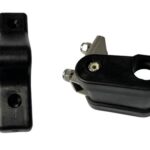Capabilities
Molding Capabilities – Plastics
Dynatect Ro-Lab has a 300 Ton Van Dorn plastic injection molding machine:

- Tonnage: 300 tons
- Shot size: 30 oz.
- Platen size: 37 x 37 inches (w x l)
- Part examples:
- Plastic components for roll-up door assembly (ranging from ~1” to 6” tall, and ½” to 2” thick) – see below
- Golf ball picker discs (for golf ball picker machine) – Manufactured in 9” and 12” diameters

How do we evaluate plastic molding manufacturing capacity?
Evaluating plastic injection molding manufacturing capacity involves considering various factors, including shot size and press tonnage. Capacity may vary based on the complexity of the parts, cycle time, and other factors:
- Understand Shot Size – Identify the range of shot sizes required for the parts you intend to manufacture. This involves understanding the volume of material needed for each shot to fill the mold cavity adequately. Shot size refers to the maximum amount of material (usually measured in weight or volume) that can be injected into the mold cavity during a single injection cycle. It is crucial to note that it is not the sum of all injection points but rather the total amount of material injected into the entire mold. Typically specified in terms of the maximum plastic that the injection molding machine can deliver in one shot, the shot size is a critical parameter directly impacting the final product’s size, shape, and properties. Determinants of shot size include the mold cavity’s size, the desired characteristics of the final product, the type of material used, and the machine’s capacity.
- Evaluate Press Tonnage – Assess the tonnage requirements based on the size and complexity of the molds. Larger, more intricate molds often require higher tonnage machines to provide sufficient clamping force. Tonnage refers to the clamping force that a molding machine can exert on the mold to keep it closed during the injection and cooling processes. It is typically measured in tons and represents the maximum force the machine can apply to keep the mold closed and resist the pressure created by the molten plastic being injected into the mold cavity.
- Calculate Production Rate – We consider the cycle time required for each part, including injection, cooling, and ejection. This helps estimate the number of parts that can be produced per hour.
While shot size and press tonnage are crucial factors, other considerations like the complexity of parts, material characteristics, and mold design also influence capacity.
Dynatect’s Ro-Lab division has extensive experience in injection molding and can provide detailed consultations tailored to the specific requirements of your manufactured part.






